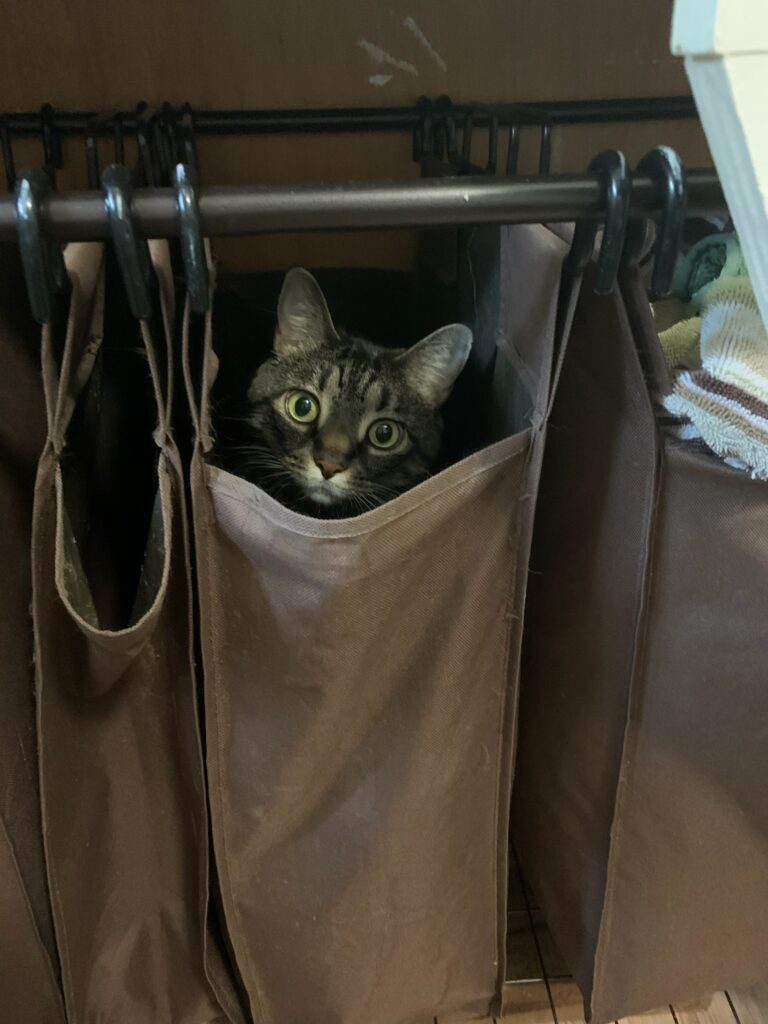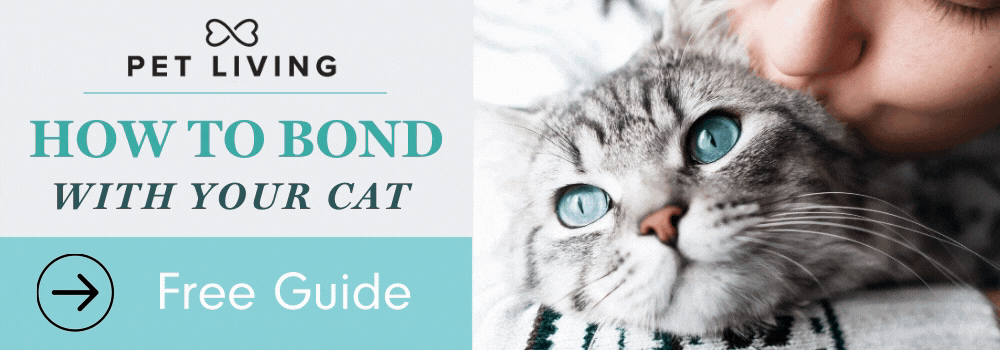
Helping Your Cat Brave the Vet: 6 Proven Techniques
This post may include affiliate links. Please read my disclosure policy.
Some cats can be more than a little salty about their vet visits. In fact, some cats become downright fearful and anxious. But it doesn’t always have to be that way.
Here’s how to tell if your cat is stressed at the vet as well as six proven techniques to help your cat brave the vet.

Why Is My Cat So Anxious At the Veterinarian?
It’s not uncommon for cats to get anxious with changes in routine and new surroundings. Most cats prefer to stay at home in their comfortable environment. Trips to the veterinarian (where they are handled, poked, and prodded) can be major triggers.
To better understand our feline family, we have to put ourselves in their paws.
Your vet’s office is likely filled with lots of different sights, sounds, and smells. Imagine your kitty getting overwhelmed by the scents of other cats, the barks and whines of anxious dogs, and perhaps seeing birds that are just beyond their reach.
In addition, some cats just don’t like being handled or touched, let alone by a stranger.
For many cats, their stress begins long before they even reach the vet’s office. The moment their carrier comes out, they get anxious, scurry away, and hide.
What Are Signs of Cat Anxiety?
Even if your cat appears to be acting like themselves ahead of their visit, they may actually be showing subtle signs of anxiety, giving you cues that they need extra TLC.
Here’s a list of symptoms that may indicate that your cat is stressed out:
- Aggression
- Becoming less active
- Clinginess
- Destructive behavior, like inappropriate scratching
- Diarrhea
- Dilated pupils
- Eating or drinking too fast
- Failing to use the litter box
- Freezing in place
- Hair loss from excessive grooming
- Hair standing up
- Hiding
- Hypervigilance
- Increased vocalization
- Increased respiratory rate
- Not eating or drinking
- Pacing
- Panting
- Salivating
- Social withdrawal
- Submission
- Trembling
- Twitching tails or ears
- Vomiting
If your cat is showing one or more of these symptoms ahead of their vet visit, they may be experiencing stress or anxiety.

In extreme cases, some pet parents may completely forgo regular vet check-ups just to avoid their cat’s adverse reactions. But this decision is riskier than taking a stressed cat to the vet.
Regular wellness checks are crucial to your cat’s health. Your veterinarian will discuss things like nutrition, weight, and dental hygiene. They’ll also monitor for other more serious conditions such as hyperthyroidism, arthritis, and kidney disease.
Routine visits are the best way to be proactive about your cat’s health and ensure that they live a long and happy life!
Still, visiting the vet with an anxious cat is rough. Thankfully, there are some basic steps you can take to keep your kitty calm for their visit to the vet.
Pin me!

6 Proven Techniques to Help Your Cat Brave The Vet
Stay calm. The more relaxed you are, the more likely your cat will stay calm too. On the day of your appointment, try to leave enough time so that you aren’t in a rush. Speaking calmly and not getting upset with your cat will help the whole process go more smoothly.
When you’re speaking, be generous with praise and commendation. They don’t always seem to listen, but cats do take note of what we say (especially our tone). So if your kitty enters their carrier with little problem, generously praise them and perhaps add in a little treat as a reward.
Help your cat associate good things with their trip to the vet.
Get your cat used to car rides. Most cats aren’t fans of car rides. But that doesn’t mean it has to be that way. In fact, with the proper conditioning, your cat may grow to look forward to them.
This will take time and patience, but once your cat feels comfortable with the smells and sounds inside the car, trips to the vet will become much easier. Start with quick rides down the street or around the block. Then work up to longer car trips.
And for safety, don’t allow them to roam free in the car. Use a carrier, like our favorite pet carrier in the next step.

Try a Sleepypod®. It’s a familiar routine that’s played out in homes across the world: you bring out the pet carrier, and your cat disappears like a furry Houdini.
But if your kitty loves their carrier and uses it on a regular basis, they’ll grow to associate it with comfort. This is one reason why we love Sleepypod – it’s a bed, carrier, and car seat all in one. The interior is made with plush shearling, ensuring your fur family has a warm place to get cozy.
Whichever carrier you decide to use, when you carry your cat in the carrier, don’t hold it by the handle and let it sway back and forth, side to side as you walk. This movement is scary and unpredictable to your cat. Instead, hold the carrier from the bottom and against your body to provide stabilization. This will make for a much less stressful transition from home to car, car to vet, etc.
Use Feliway® to calm your cat. Feliway is a vet-recommended, drug-free way to restore your cat’s peace. This spray mimics natural feline pheromones that help your cat feel calm in stressful situations like car rides to the vet.
You can spray it directly onto your cat’s carrier (but not directly onto your cat), their favorite blanket, and even in the car 20 minutes before your trip to the vet. It’s great for on-the-go and can curb the unwanted behaviors of a stressed-out kitty, like scratching, hiding, and even urine spraying.
- Vet recommended as a way to help cats in challenging situations and curb stress-related behaviors like urine spraying and scratching
- Makes vet visits, travel, new environments, and loud noises less stressful for your cat
- Drug free solution that mimics your cat's natural facial pheromones to help them feel calmer in common stressful situations
Get professional help for severe cases. You aren’t alone in your struggle to get your anxious cat to the vet. If your kitty is showing extreme symptoms of anxiety, reach out to your veterinarian for help.
Describe your cat’s symptoms and what you’ve tried to do to remedy the situation. Your vet may decide that prescription medication is the best solution to relieve your fur family’s stress and anxiety.
They may also suggest that you visit a veterinary behaviorist. These professionals are specially trained in animal behavior and can formulate a treatment plan for your cat. To find a certified veterinary behaviorist near you, go to the American College of Veterinary Behaviorists’ website.
Make an Appointment with a Fear Free® Veterinarian
Here at Pet Living, we’re big advocates of the Fear Free initiative. It was founded by Dr. Marty Becker, and developed by hundreds of veterinary professionals. The purpose of the program is to create a gentle, calming environment for your pet to care for their emotional well-being while also providing for their physical health.

Mikkel Becker, Lead Animal Trainer for Fear Free Pets and the co-author of From Fearful to Fear Free, comments on the unique Fear Free experience: “With Fear Free, it’s really about keeping the pet with the pet parent as much as possible. Having their pet parent nearby brings that comfort. It’s all about their emotional health.”
I love my dog Tulip’s Fear Free Vet practice in Waynesville, North Carolina. Everything was done in the room. And Tulip was so much more comfortable with me in the room.
During a Fear Free visit, doctors and technicians bring everything they need into the exam room. This is so important because every time the door opens, it can activate anxiety in your pet. This thoughtful approach helps them stay calm.
Ask your vet if they have Fear Free℠ Certified Professionals on their team. Or you can search the Fear Free website for a professional near you.
The Tail End
Trips to the veterinarian don’t have to be stressful. It takes preparation, patience, and a calm disposition to help your kitty overcome their fears and brave the vet’s office like a courageous cat.
These six proven techniques will help you keep your regular vet appointments, and, best of all, they’ll help your feline friend feel safe, loved, and secure.










Comments (0)